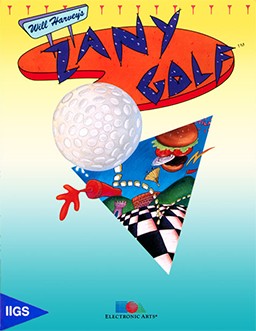
Zany Golf, also known as Will Harvey's Zany Golf, is a fantasy take on miniature golf developed by Sandcastle Productions and published by Electronic Arts in 1988. The game was originally written for the Apple IIGS and subsequently ported to the Amiga, Atari ST, and MS-DOS compatible operating systems. In 1990, a port was released for the Sega Genesis. The game was developed by Will Harvey, Ian Gooding, Jim Nitchals, and Douglas Fulton. Harvey was pursuing his advanced degrees at Stanford University at the time.

Skate or Die! is a skateboarding video game released by Electronic Arts (EA) in 1987 for the Commodore 64. It is EA's first internally developed game. Versions for the Apple IIGS, MS-DOS, Amstrad CPC, and ZX Spectrum followed. It was ported to the Nintendo Entertainment System by Konami, published under the company's Ultra Games branding.

Operation Wolf is a light gun shooter arcade game developed by Taito and released in 1987. It was ported to many home systems.
Thalamus Ltd was a British computer game developer that published titles for a number of 8-bit and 16-bit platforms during the late 1980s and early 1990s.
Newsfield Publications Ltd was a British magazine publisher during the 1980s and early 1990s.

Star Goose is a vertically scrolling shooter that was published for the Amiga, Atari ST, and MS-DOS by Logotron in 1988. The player controls Scouser-Gitt, who pilots the eponymous Star Goose, a vessel that has been commissioned to scour the planet Nom and collect 48 crystals. Players must collect all six crystals in each of the game's eight levels to advance, while at the same time avoiding or destroying enemies and maintaining their shield, ammunition, and fuel levels. The game's surfaces are contoured, which affects the way that bullets travel, and contain tunnels that switch modes to a three-dimensional perspective where the player can replenish their resources.
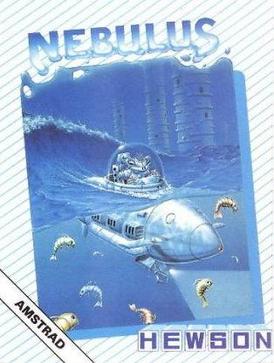
Nebulus is a platform game created by John M. Phillips and published by Hewson Consultants in the late 1980s for home computer systems. International releases and ports were known by various other names: Castelian, Kyorochan Land, Subline, and Tower Toppler.

Carrier Command is a 1988 video game published by Rainbird for the Amiga, Atari ST, IBM PC compatibles, ZX Spectrum, Macintosh, Commodore 64, and Amstrad CPC. Carrier Command is a cross between a vehicle simulation game and a real-time strategy game where players control a robotic aircraft carrier.

Special Criminal Investigation, also known as S.C.I. for short or as Chase HQ II: Special Criminal Investigation in some home versions, is vehicular combat racing game published by Taito for arcades in 1989. It is the sequel to the 1988 game Chase H.Q.
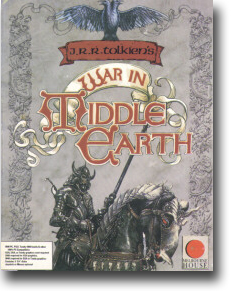
War in Middle Earth is a real-time strategy game released for the ZX Spectrum, MSX, Commodore 64, Amstrad CPC, MS-DOS, Amiga, Apple IIGS, and Atari ST in 1988 by Virgin Mastertronic on the Melbourne House label.

Arcticfox is a science fiction tank simulation video game developed by Dynamix and published by Electronic Arts in 1986. It was published in Europe by Ariolasoft. A sequel to Dynamix's Stellar 7, Arcticfox was developed for the Amiga as one of the platform's first titles but was quickly ported to other platforms including the Atari ST, Commodore 64, ZX Spectrum, MS-DOS and Apple II. A third game was released in the series in 1991 titled Nova 9: The Return of Gir Draxon.
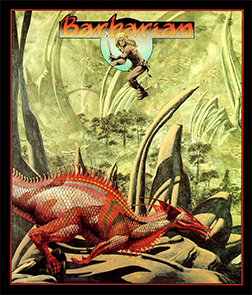
Barbarian is a 1987 platform game by Psygnosis. It was first developed for the Atari ST, and was ported to the Amiga, Commodore 64, MS-DOS, MSX, Amstrad CPC, and ZX Spectrum. The Amiga port was released in 1987; the others were released in 1988. The cover artwork is by fantasy artist Roger Dean.

F/A-18 Interceptor is a combat flight simulator developed by Intellisoft and published by Electronic Arts for the Amiga in 1988. The player mainly flies the F/A-18 Hornet, but the F-16 Fighting Falcon is also available for aerobatics, free flight and the first mission. Contrary to the title of the game, the real F/A-18 is not a true interceptor aircraft, having been designed instead as a multirole anti-ship strike fighter.

Tiger Road is a hack and slash platform game originally released in 1987 as a coin-operated arcade video game.
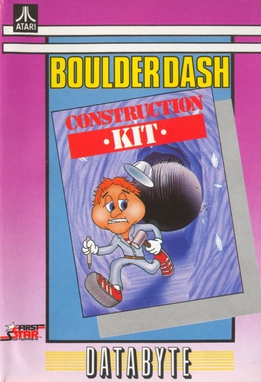
Boulder Dash Construction Kit is the fourth game in the Boulder Dash series. It was published for the Commodore 64 and Atari 8-bit computers in 1986 by Epyx. Ports were released for the Apple II, Atari ST, Amiga, Amstrad CPC, ZX Spectrum, and MS-DOS. The Spectrum version was rereleased as Boulder Dash IV: The Game. Boulder Dash Construction Kit includes new levels and a level editor.

The Real Ghostbusters is a 1987 shoot 'em up arcade game developed and published by Data East. It is loosely based on Ghostbusters. In Japan, Data East released it as a non-Ghostbusters arcade game under the title Meikyuu Hunter G. In 1989, Activision published The Real Ghostbusters for Amiga, Amstrad CPC, Atari ST, Commodore 64, and ZX Spectrum.
Scetlander was a software publisher which released titles for various 8- and 16-bit home computer systems in the 1980s and 1990s.

Mickey Mouse: The Computer Game, also known as just Mickey Mouse, is an action game developed and published by Gremlin Graphics in 1988 for the Amiga, Amstrad CPC, Atari ST, Commodore 64, and ZX Spectrum.

TV Sports: Football is a 1988 video game by Cinemaware for Amiga, Atari ST, Commodore 64, DOS, and TurboGrafx-16.
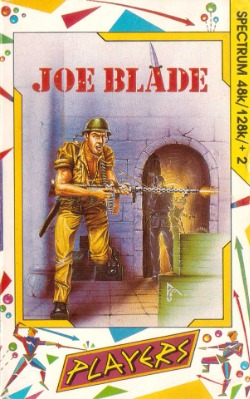
Joe Blade is a video game published by Interceptor Micros on their Players budget label for the ZX Spectrum, Commodore 64 and Amstrad CPC in 1987. It reached the top of the UK game charts, replacing Renegade. In Germany, the game peaked at number 7. It was ported to the Acorn Electron, BBC Micro, Atari 8-bit computers, MSX, Amiga, and Atari ST. A sequel, Joe Blade 2, was published in 1988. Another sequel, Joe Blade 3, was released in 1989.


















